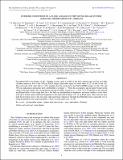Files in this item
Extreme conditions in a close analog to the young solar system : Herschel observations of ∈ Eridani
Item metadata
| dc.contributor.author | Greaves, Jane Sophia | |
| dc.contributor.author | Sibthorpe, B. | |
| dc.contributor.author | Acke, B. | |
| dc.contributor.author | Pantin, E. E. | |
| dc.contributor.author | Vandenbussche, B. | |
| dc.contributor.author | Olofsson, G. | |
| dc.contributor.author | Dominik, C. | |
| dc.contributor.author | Barlow, M. J. | |
| dc.contributor.author | Bendo, G. J. | |
| dc.contributor.author | Blommaert, J. A. D. L. | |
| dc.contributor.author | Brandeker, A. | |
| dc.contributor.author | de Vries, B. L. | |
| dc.contributor.author | Dent, W. R. F. | |
| dc.contributor.author | Di Francesco, J. | |
| dc.contributor.author | Fridlund, M. | |
| dc.contributor.author | Gear, W. K. | |
| dc.contributor.author | Harvey, P. M. | |
| dc.contributor.author | Hogerheijde, M. R. | |
| dc.contributor.author | Holland, W. S. | |
| dc.contributor.author | Ivison, R. J. | |
| dc.contributor.author | Liseau, R. | |
| dc.contributor.author | Matthews, B. C. | |
| dc.contributor.author | Pilbratt, G. L. | |
| dc.contributor.author | Walker, H. J. | |
| dc.contributor.author | Waelkens, C. | |
| dc.date.accessioned | 2015-09-16T09:40:01Z | |
| dc.date.available | 2015-09-16T09:40:01Z | |
| dc.date.issued | 2014-08-10 | |
| dc.identifier | 152896592 | |
| dc.identifier | e383ee15-20e5-49a0-90ee-90ada38f0a6f | |
| dc.identifier | 000341302200011 | |
| dc.identifier | 84905251583 | |
| dc.identifier | 000341302200011 | |
| dc.identifier.citation | Greaves , J S , Sibthorpe , B , Acke , B , Pantin , E E , Vandenbussche , B , Olofsson , G , Dominik , C , Barlow , M J , Bendo , G J , Blommaert , J A D L , Brandeker , A , de Vries , B L , Dent , W R F , Di Francesco , J , Fridlund , M , Gear , W K , Harvey , P M , Hogerheijde , M R , Holland , W S , Ivison , R J , Liseau , R , Matthews , B C , Pilbratt , G L , Walker , H J & Waelkens , C 2014 , ' Extreme conditions in a close analog to the young solar system : Herschel observations of ∈ Eridani ' , Astrophysical Journal Letters , vol. 791 , no. 1 . https://doi.org/10.1088/2041-8205/791/1/L11 | en |
| dc.identifier.issn | 2041-8205 | |
| dc.identifier.uri | https://hdl.handle.net/10023/7476 | |
| dc.description.abstract | Far-infrared Herschel images of the Eridani system, seen at a fifth of the Sun's present age, resolve two belts of debris emission. Fits to the 160 μm PACS image yield radial spans for these belts of 12-16 and 54-68 AU. The south end of the outer belt is ≈10% brighter than the north end in the PACS+SPIRE images at 160, 250, and 350 μm, indicating a pericenter glow attributable to a planet "c." From this asymmetry and an upper bound on the offset of the belt center, this second planet should be mildly eccentric (ec ≈ 0.03-0.3). Compared to the asteroid and Kuiper Belts of the young Sun, the Eri belts are intermediate in brightness and more similar to each other, with up to 20 km sized collisional fragments in the inner belt totaling ≈5% of an Earth mass. This reservoir may feed the hot dust close to the star and could send many impactors through the Habitable Zone, especially if it is being perturbed by the suspected planet Eri b, at semi-major axis ≈3 AU. | |
| dc.format.extent | 5 | |
| dc.format.extent | 278067 | |
| dc.language.iso | eng | |
| dc.relation.ispartof | Astrophysical Journal Letters | en |
| dc.subject | Circumstellar matter | en |
| dc.subject | Planet-disk interactions | en |
| dc.subject | Stars: individual (is an element of Eridani) | en |
| dc.subject | Star epison-eridani | en |
| dc.subject | Devris disk | en |
| dc.subject | Size distributions | en |
| dc.subject | Vega | en |
| dc.subject | Planets | en |
| dc.subject | Evolution | en |
| dc.subject | Migration | en |
| dc.subject | Spitzer | en |
| dc.subject | Belt | en |
| dc.subject | Mass | en |
| dc.subject | QB Astronomy | en |
| dc.subject | QC Physics | en |
| dc.subject.lcc | QB | en |
| dc.subject.lcc | QC | en |
| dc.title | Extreme conditions in a close analog to the young solar system : Herschel observations of ∈ Eridani | en |
| dc.type | Journal article | en |
| dc.contributor.sponsor | Science & Technology Facilities Council | en |
| dc.contributor.institution | University of St Andrews. School of Physics and Astronomy | en |
| dc.identifier.doi | 10.1088/2041-8205/791/1/L11 | |
| dc.description.status | Peer reviewed | en |
| dc.identifier.grantnumber | ST/J001651/1 | en |
This item appears in the following Collection(s)
Items in the St Andrews Research Repository are protected by copyright, with all rights reserved, unless otherwise indicated.

